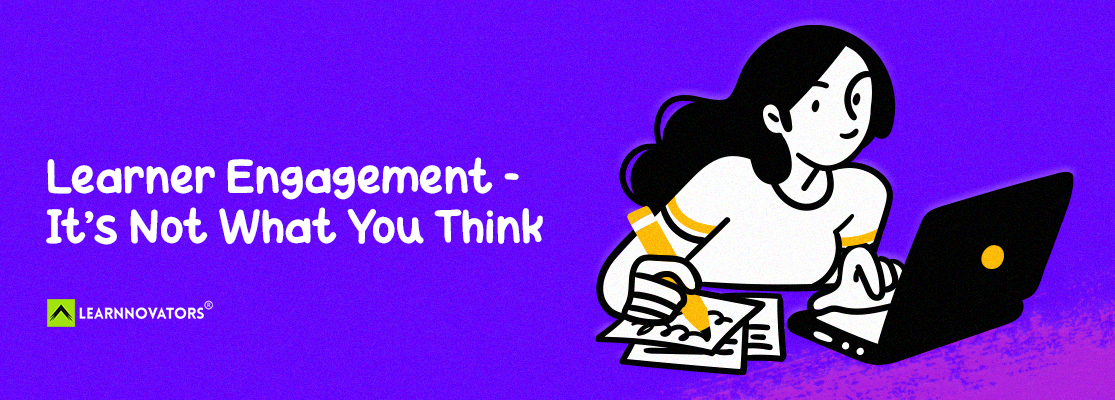I’ve always been fascinated with the idea of learner engagement.
And rightly so.
If you do anything remotely connected with instructional design, you would be too.
Because it’s engagement that opens up the gates to learner involvement in the course. It gets them committed to the outcomes, and then makes them work hard towards ‘getting there’.
But unfortunately today, the term learner engagement gets bandied about meaninglessly. Or at least, I get the feeling that people (a.k.a., instructional designers) don’t really understand why engagement is important, or how to focus on the right kind of engagement. I’ve written about it here.
So, here I am with a clarification, and an example.
Let’s start off by talking about who is an engaged learner.
An engaged learner is one who believes that it is truly important to them to learn the concerned topic. In other words, they are sold on the subject of the course, and therefore, are wholeheartedly invested in the learning process. They are excited and motivated by what the course has to offer, and are willing to put in the effort to make their learning experience a successful one.
How about a course that offers lots of interactivity and stunning visuals? Are learners engaged when participating in such a course?
Maybe they are. Maybe they aren’t. It depends on a couple of factors, at least.
- Is the interactivity supporting a real-world scenario that makes learners think hard before selecting an answer? If yes, then they’re engaged. If it is simply making them click a lot, then they’re probably not.
- Are the visuals augmenting the content in a way that they help make a point or elaborate a concept? If yes, then they are engaging. If the visuals exist only because they look good, they aren’t.
The kind of engagement brought about by a lot of empty interactivity and visuals is referred to as behavioral engagement. This, according to experts, is the shallowest kind of engagement. And as designers, we want to move away from this.
On the other hand, there are two kinds of engagement we want to seek out and incorporate in our courses. These are…
Emotional Engagement
This involves helping learners understand why they should care for the topic. In quintessential marketing terminology, it is the What’s In It For Me (or WIIFM).
While the WIIFM pulls learners into the course, there are other elements within the course that should keep learners engaged, or in other words, interested in the topic. This can be brought about by storytelling or other emotional factors, such as using examples and scenarios that are relatable and personal.
For example, if a scenario is about a challenge that the learner faces on the job regularly, then they are immediately drawn in and engaged.
Cognitive Engagement
This is the kind of engagement that requires mental effort on the part of the learner.
While there are many ways to bring about cognitive engagement, the most common, and perhaps the most impactful, is practice scenarios.
The practice needs to be:
- Meaningful (as in, closely related to their workplace context), and
- Effortful (it should get them to think hard and make decisions, similar to how they would in their workplace)
Also, the practice should invoke the right level of effort. Too hard, and it can lead to frustration and the learner giving up too soon. Too easy, and it can lead to boredom, and once again, the learner giving up too soon.
Meanwhile, here is an example that will help you think about the different kinds of engagement. Read the question and try to respond in your mind before checking out the answer.
Question:
You are midway through the design of an e-learning program, and your client suggests adding points to make it gamified, and to spice up the experience of the course. What kind of engagement would this be? And would it add value to the learner and engage them at a deeper level?
Answer:
Behavioral engagement. While gamification is a good learning strategy, adding it as an afterthought is not likely to engage learners at a deeper level. If you do want to make these points valuable as an engagement tool, ask yourself the following:
- Do the points lead to something? In other words, what would learners do with the points they’ve earned? If your answer is ‘nothing’, then it’s straight away a bad idea to include them in your course.
- Are the points supportive of the remaining elements in the course? If yes, keep them, and if not, discard them.
Behavioral engagement, in the form of empty interactions, gamification, catchy visuals etc., might have a value of its own, but in most cases, it can be detrimental to the deeper engagement that we’re looking for. Check out our follow-up posts on the ways we can bring about emotional and cognitive engagement.
Written by Srividya Kumar, Co-Founder @ Learnnovators






